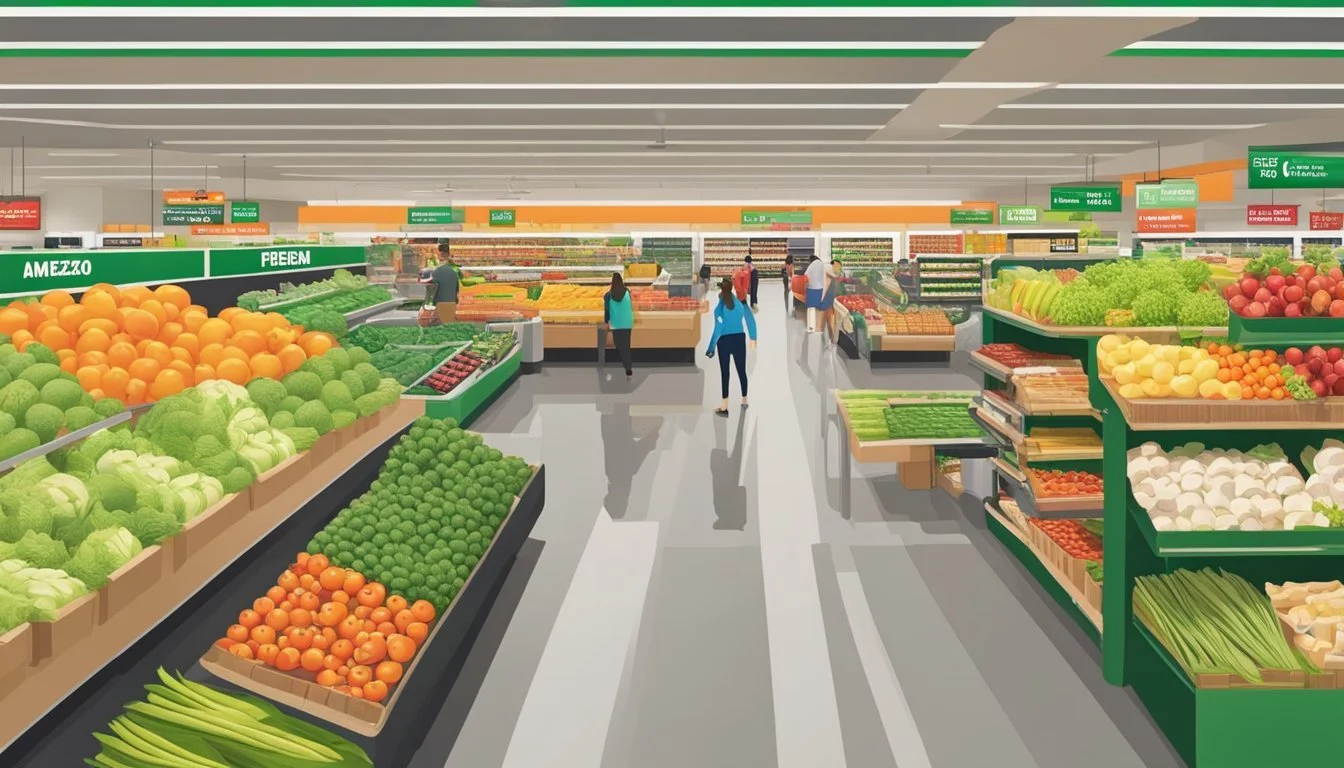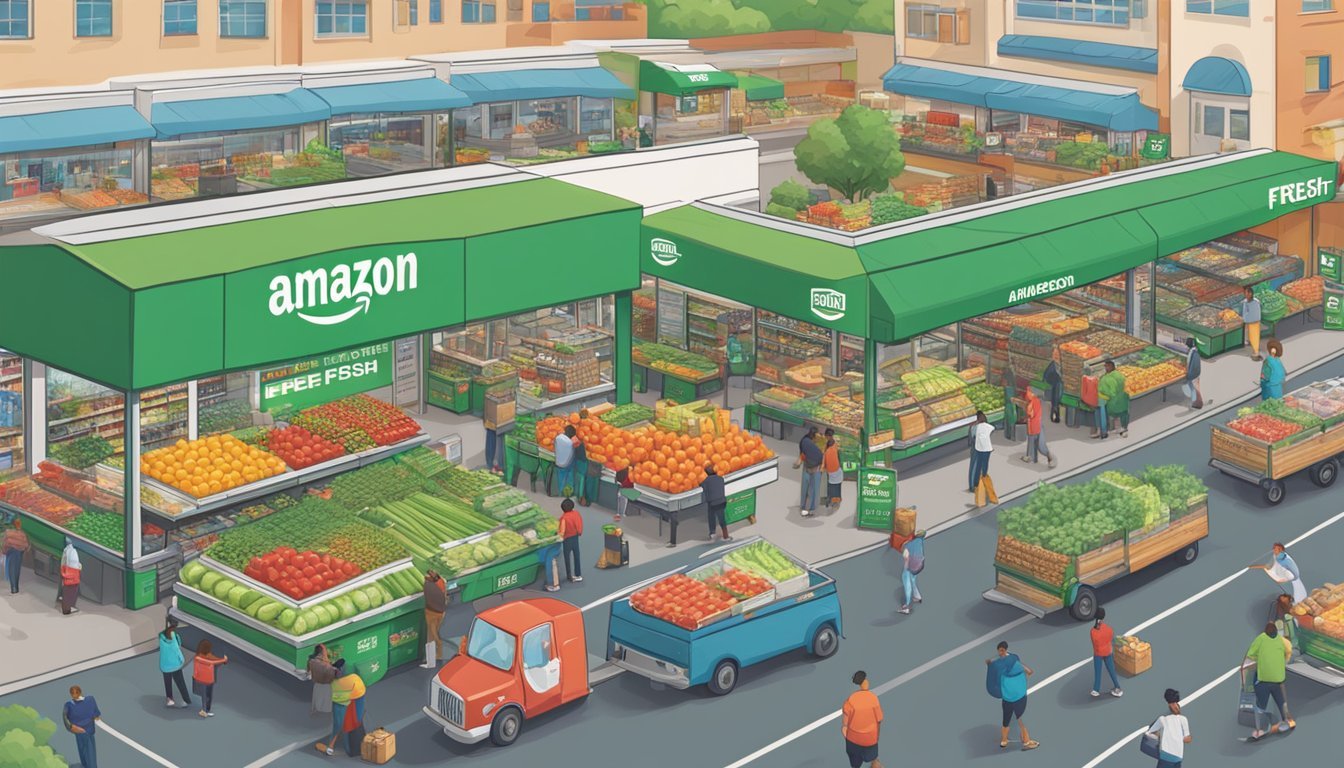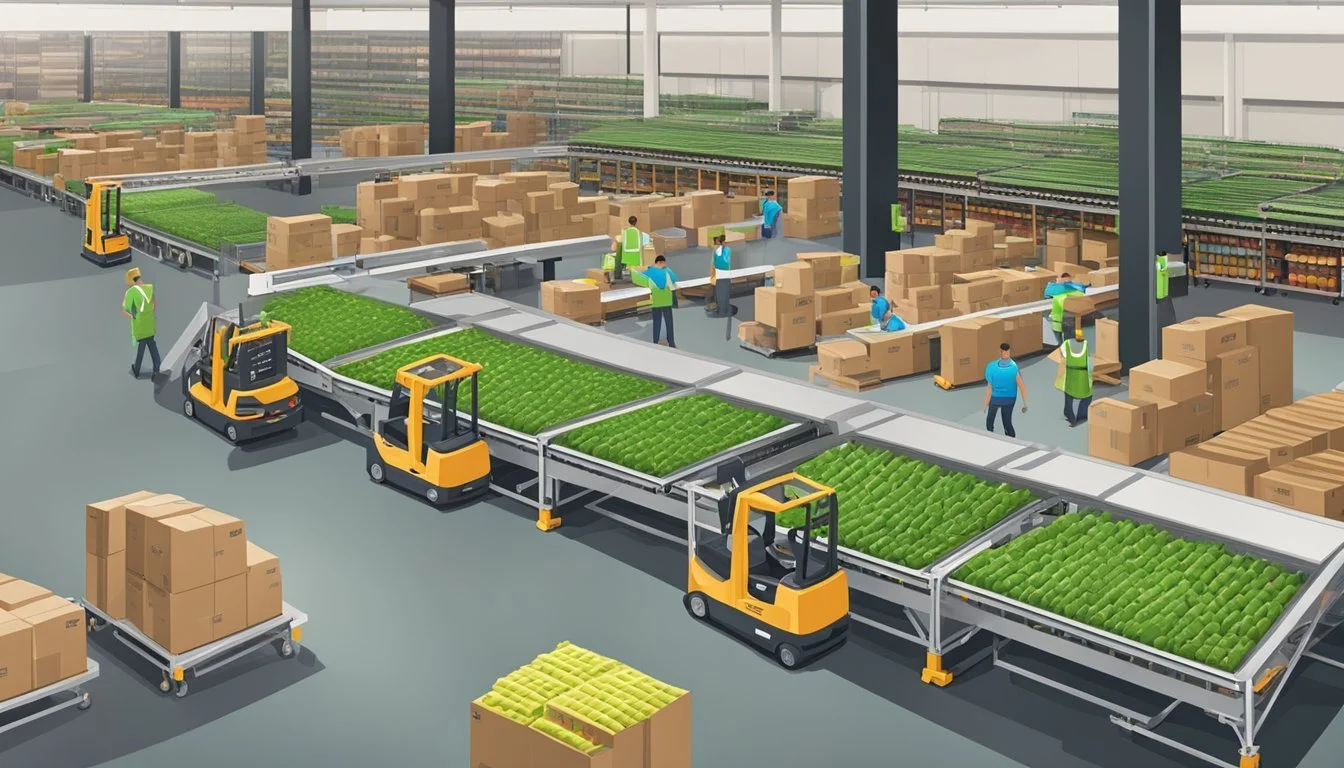Amazon Fresh vs H-E-B
A Comprehensive Comparison of Price, Quality, and Convenience
Amazon Fresh and H-E-B are two prominent players in the grocery retail landscape, each with its unique strengths and customer appeal. Both stores have garnered loyal followings and offer diverse product selections to meet shoppers' needs.
Amazon Fresh typically offers competitive prices and convenient delivery options, making it an attractive choice for those prioritizing convenience and cost savings. The online giant's grocery arm leverages its vast distribution network to provide a wide array of products at competitive rates, often undercutting traditional brick-and-mortar stores.
H-E-B, a beloved Texas-based chain, has built its reputation on exceptional customer service, high-quality products, and a strong community presence. The store's commitment to local sourcing and regional specialties has endeared it to many shoppers, particularly in its home state. While H-E-B may not always match Amazon Fresh's prices, it compensates with a superior in-store experience and a curated selection of unique products.
Overview of Amazon Fresh and H-E-B
Amazon Fresh and H-E-B represent two distinct approaches to grocery retail, each with unique strengths and service models. Their contrasting histories and market strategies have shaped their current positions in the competitive grocery landscape.
Brand Histories and Market Presence
Amazon Fresh launched in 2007 as an online grocery delivery service. It has since expanded to include physical stores in select U.S. cities. The brand leverages Amazon's e-commerce expertise and Prime membership base.
H-E-B, founded in 1905 in Texas, has grown into a regional powerhouse with over 340 stores across Texas and Mexico. The company is known for its strong community ties and localized product offerings.
Amazon Fresh operates primarily in urban areas, while H-E-B maintains a strong presence in Texas and parts of Mexico. Both brands have cultivated loyal customer bases through their distinct approaches to grocery retail.
Service Models and Shopping Experience
Amazon Fresh offers a tech-driven shopping experience. Its physical stores feature "just walk out" technology, allowing customers to shop without traditional checkouts. The brand also provides online ordering with delivery and pickup options.
H-E-B focuses on a more traditional in-store experience, enhanced by modern conveniences. They offer a wide range of products, including many local and Texas-made items. The company has also developed its own online ordering and delivery services.
Both retailers emphasize fresh produce and prepared foods. Amazon Fresh integrates with Prime membership benefits, while H-E-B offers a popular loyalty program. Customer service is a priority for both, with H-E-B particularly known for its friendly staff and community engagement.
Grocery Shopping and Delivery Services
Amazon Fresh and H-E-B offer various options for getting groceries to customers. These include delivery and pickup services with different features and pricing structures.
Comparing Delivery Options
Amazon Fresh provides same-day delivery in select cities for Prime members. Orders over $35 qualify for free delivery, while smaller orders incur a $9.99 fee. Two-hour delivery windows are available for added convenience.
H-E-B partners with Instacart for grocery delivery. Fees vary based on order size and delivery time, typically ranging from $3.99 to $9.99. Express delivery within 2 hours is offered for an additional charge.
Both services allow customers to schedule deliveries in advance. Amazon Fresh offers more flexibility with delivery windows as short as one hour.
Availability of Pickup Options
Amazon Fresh offers free pickup at select Whole Foods locations for Prime members. Customers can choose a 30-minute pickup window and have their groceries brought to their car.
H-E-B provides curbside pickup at most store locations. Orders can be placed up to 7 days in advance. A small service fee applies, usually around $4.95.
Both services offer same-day pickup options, with H-E-B allowing orders to be ready in as little as 2 hours.
Grocery Delivery Services Reliability
Amazon Fresh leverages its extensive logistics network to ensure timely deliveries. Prime members benefit from real-time tracking and delivery notifications.
H-E-B's partnership with Instacart provides a reliable delivery service. Shoppers communicate with customers about substitutions and out-of-stock items.
Both services have implemented measures to ensure food safety during transport. Perishable items are packed with insulated bags and ice packs when necessary.
Amazon Fresh and H-E-B maintain high standards for order accuracy. However, occasional errors can occur with both services, especially during peak times.
Pricing and Membership
Amazon Fresh and H-E-B employ different pricing strategies and membership models. Costs for groceries, delivery, and additional services vary between the two retailers. Understanding these differences can help shoppers make informed decisions about where to purchase their groceries.
Understanding Membership Costs
Amazon Fresh requires a Prime membership, priced at $139 annually or $14.99 monthly. This subscription includes access to other Amazon services. H-E-B, as a traditional grocery store, does not require a membership to shop in-store. However, H-E-B offers a free loyalty program called H-E-B Points Club, which provides rewards and discounts to members.
For online ordering, H-E-B partners with Instacart. Instacart offers its own membership called Instacart+, priced at $99 annually or $9.99 monthly, providing free delivery on orders over $35.
Delivery Fees and Additional Charges
Amazon Fresh offers free delivery for Prime members on orders over $35-$50, depending on the location. Orders below this threshold incur a delivery fee. H-E-B's delivery fees vary based on order size and delivery time, typically ranging from $3.95 to $9.95.
Both services may apply additional fees during peak times or for rush deliveries. Tipping is optional but encouraged for both Amazon Fresh and H-E-B delivery drivers.
Comparative Cost Analysis
Grocery prices at Amazon Fresh are generally competitive with traditional supermarkets. H-E-B is known for offering competitive prices, especially on their store-brand products.
Item Amazon Fresh H-E-B Bananas (2 lb) $1.29 $1.18 Avocado (1 large) $1.72 $1.48 Milk (1 gallon) $3.69 $3.28
While prices may vary by location and season, H-E-B often edges out Amazon Fresh on everyday grocery items. However, Amazon Fresh frequently offers exclusive deals for Prime members, potentially leading to significant savings on specific products.
Product Range and Grocery Quality
Amazon Fresh and H-E-B offer diverse product ranges and prioritize quality in their grocery selections. Both stores strive to meet customer needs with fresh produce, meats, and a variety of other food items.
Freshness and Food Quality
Amazon Fresh emphasizes freshness in its perishables. Their produce arrives quickly from suppliers, maintaining optimal quality. The company's efficient delivery system helps preserve the freshness of fruits, vegetables, and dairy products.
H-E-B is known for its high-quality fresh produce and meats. The Texas-based chain sources many items locally, ensuring peak freshness. H-E-B's in-store butchers provide custom cuts of meat, appealing to customers seeking premium quality.
Both stores have strict quality control measures. They regularly inspect their products to ensure customers receive fresh, safe groceries.
Variety of Selection
Amazon Fresh offers a wide selection of national brands and private label products. Their online platform allows for a vast inventory, including specialty and international items.
H-E-B provides an extensive range of products, including their own private label brands. The store is known for its diverse selection of Texas-made products and regional favorites.
Both retailers stock a full range of grocery categories. This includes pantry staples, snacks, beverages, frozen foods, and household items.
Availability of Organic and Local Products
Amazon Fresh carries organic options, including products from their 365 by Whole Foods Market line. They offer a selection of organic produce, meats, and packaged goods.
H-E-B excels in providing local products. They partner with Texas farmers and producers to offer a wide range of locally-sourced items. Their organic selection includes both national brands and their own organic line.
Both stores cater to health-conscious consumers. They stock various organic, non-GMO, and specialty diet products to meet diverse customer needs.
Customer Service and Shopping Convenience
Amazon Fresh and H-E-B prioritize customer satisfaction through their digital platforms and support services. Both retailers offer unique features to enhance the shopping experience.
Ease of Use for Websites and Apps
Amazon Fresh's website and app integrate seamlessly with existing Amazon accounts. The interface allows easy browsing, searching, and reordering of previous purchases. H-E-B's digital platform offers a user-friendly design with intuitive navigation. Both apps enable list creation and provide personalized recommendations based on shopping history.
H-E-B's app includes a barcode scanner for quick product lookups. Amazon Fresh offers voice ordering through Alexa devices. Both platforms allow customers to schedule deliveries or select pickup times.
Responsiveness and Support
Amazon Fresh leverages Amazon's established customer service infrastructure. Support is available 24/7 through phone, email, and chat. H-E-B provides dedicated support for online orders during store hours. Both retailers offer quick resolution for order issues and refunds.
H-E-B's local presence allows for more personalized in-store assistance. Amazon Fresh relies on remote support but benefits from extensive knowledge bases and FAQs.
Convenience Features and Benefits
Amazon Fresh integrates with Prime memberships, offering free delivery on orders over a certain threshold. The service provides real-time order tracking and allows last-minute changes. H-E-B offers curbside pickup at many locations, with dedicated parking spots for quick order retrieval.
H-E-B's digital coupons automatically apply to orders. Amazon Fresh features a "Buy Again" section for easy reordering of frequent purchases. Both services offer contactless delivery options and the ability to leave specific instructions for drivers.
Exclusive Offers and Savings
Amazon Fresh and H-E-B both provide unique ways for customers to save money on groceries. Each store offers different perks, discounts, and pricing strategies to attract and retain shoppers.
Membership Perks and Prime Benefits
Amazon Fresh leverages its Prime membership program to offer exclusive benefits. Prime members enjoy free delivery on orders over $100 and an additional 10% off select items. This can lead to significant savings for frequent shoppers.
H-E-B, while not subscription-based, provides a free loyalty program called H-E-B Points. Members earn points on purchases, which can be redeemed for discounts on future shopping trips.
Amazon's credit card holders receive extra cashback on Fresh purchases, boosting potential savings. H-E-B partners with specific credit cards to offer bonus rewards at their stores.
Discounts and Coupons Usage
Both retailers employ various discount strategies. Amazon Fresh regularly rotates weekly deals on 4,000 grocery items, including their private label products. These discounts are available both in-store and online.
H-E-B offers digital coupons through their mobile app, which can be easily applied at checkout. They also run weekly specials and combo deals, allowing customers to save on multiple items.
Amazon Fresh integrates with Alexa for voice-activated shopping lists and deal notifications. H-E-B's app sends personalized offers based on shopping history.
Price Comparison with Other Retailers
Amazon Fresh often beats traditional grocery stores on prices across many categories. Their competitive pricing strategy aims to attract budget-conscious shoppers.
H-E-B is known for its aggressive pricing in regions where it operates. They frequently match or beat competitors' prices on common household items.
Amazon's scale allows for bulk purchasing power, potentially leading to lower prices. H-E-B leverages strong relationships with local suppliers to keep costs down.
Both stores offer price matching policies, though terms may vary. Shoppers can often find the best deals by comparing prices between these two retailers and other local options.
Operational Aspects and Logistics
Amazon Fresh and H-E-B employ different strategies to manage their grocery operations and logistics. Their approaches to streamlining shopping, inventory management, and adapting to pandemic-era challenges reveal key differences between the two retailers.
Streamlining Grocery Shopping
Amazon Fresh leverages technology to enhance the shopping experience. Customers can use smart carts equipped with cameras and sensors to automatically track purchases. This eliminates the need for traditional checkout lines.
H-E-B focuses on a hybrid model. They offer curbside pickup and delivery services through their app and website. In-store, H-E-B provides self-checkout options alongside traditional cashier lanes.
Both retailers use data analytics to optimize product placement and inventory levels. This helps reduce congestion and improves the overall flow of customers through stores.
Handling Stock and Out-of-Stock Items
Amazon Fresh utilizes advanced inventory management systems. Their automated warehouses and fulfillment centers allow for real-time tracking of stock levels. When items run low, automated reordering processes kick in to replenish inventory quickly.
H-E-B relies on a mix of technology and human expertise. Store managers have more autonomy in managing local inventory. They can adjust orders based on regional preferences and seasonal demands.
Both retailers face challenges with popular items like bananas going out of stock. Amazon Fresh often substitutes unavailable items automatically. H-E-B typically contacts customers to approve substitutions or removals.
Implications of Pandemic on Grocery Delivery
The COVID-19 pandemic dramatically increased demand for online grocery services. Amazon Fresh expanded its delivery fleet and warehouse capacity to meet the surge in orders. They introduced contactless delivery options and prioritized essential items.
H-E-B rapidly scaled up its existing curbside and delivery services. They partnered with Instacart to increase delivery capacity. H-E-B also implemented strict safety protocols for in-store shoppers and delivery personnel.
Both retailers faced challenges in maintaining stock levels of high-demand items. They had to adjust their supply chains and implement purchase limits on certain products. The pandemic accelerated the adoption of online grocery shopping, leading to long-term changes in consumer behavior.
Pros and Cons of Amazon Fresh and H-E-B
Amazon Fresh and H-E-B offer distinct shopping experiences with unique advantages and drawbacks. Both retailers have strengths that appeal to different customer needs and preferences.
Advantages of Choosing Amazon Fresh
Amazon Fresh provides convenient online ordering and delivery options. Prime members can easily add groceries to their existing subscriptions.
The service offers a wide selection of products, including Whole Foods items. This variety caters to diverse dietary needs and preferences.
Amazon Fresh stores feature innovative "just walk out" technology. This allows customers to shop without traditional checkouts, saving time.
Competitive pricing is often available, especially for Prime members. Regular deals and discounts can lead to savings on grocery bills.
Benefits of Shopping at H-E-B
H-E-B is known for its strong community presence and local product offerings. The chain supports regional producers and tailors its inventory to local tastes.
The stores provide a traditional in-person shopping experience. This allows customers to personally select fresh produce and meats.
H-E-B's private label products offer quality at competitive prices. These items often match or exceed national brands in taste and value.
The company is recognized for its customer service and employee satisfaction. This translates to a positive shopping environment for customers.
Comparative Drawbacks to Consider
Amazon Fresh requires a Prime membership for full benefits. This additional cost may not be worthwhile for infrequent shoppers.
The service is not available in all areas. Rural or less populous regions may lack access to Amazon Fresh delivery or stores.
H-E-B's physical presence is limited to certain states. This restricts access for customers outside its operating regions.
In-store shopping at H-E-B can be time-consuming. Busy periods may lead to long checkout lines and crowded aisles.
Amazon Fresh's reliance on technology may be challenging for some users. Technical issues or user unfamiliarity can complicate the shopping process.
H-E-B may have higher prices on some items compared to online alternatives. This can impact overall grocery costs for budget-conscious shoppers.
Environmental and Community Impact
Amazon Fresh and H-E-B both prioritize environmental sustainability and community engagement. Their efforts impact local economies and ecosystems through various initiatives and programs.
Corporate Social Responsibility
H-E-B's corporate social responsibility focuses on local community support. The company donates 5% of pre-tax profits to charitable causes annually. H-E-B's disaster relief efforts provide aid during hurricanes and other emergencies in Texas.
Amazon Fresh, as part of Amazon, participates in broader corporate initiatives. The company has pledged $2 billion to support affordable housing in its operational areas. Amazon's Career Choice program offers educational opportunities for employees.
Both retailers support food banks and hunger relief programs. H-E-B's Food Bank Assistance Program has donated over 300 million pounds of food since 1982.
Sustainability Initiatives and Food Waste Reduction
H-E-B emphasizes sustainable practices in its operations. The company has reduced its carbon footprint by 24% since 2015 through energy-efficient store designs and solar panel installations. H-E-B's food waste reduction program diverts unsold food to composting facilities.
Amazon Fresh implements Amazon's company-wide sustainability goals. The retailer uses electric delivery vehicles to reduce emissions. Amazon Fresh stores feature energy-efficient refrigeration systems and LED lighting.
Both companies offer organic items and work with local farmers. H-E-B's Go Local program sources produce from Texas growers. Amazon Fresh partners with regional suppliers to reduce transportation distances.
Future Trends in Grocery Shopping
The grocery industry is rapidly evolving with technological advancements and changing consumer preferences. Innovations are reshaping both online and in-store experiences, while retailers strive to anticipate and meet evolving customer needs.
Innovations in Online and In-store Experiences
Artificial intelligence is revolutionizing grocery shopping. AI-powered systems provide personalized product recommendations and tailored promotions based on individual shopping habits. Retailers are investing in smart carts and cashier-less checkout technologies to streamline the in-store experience.
Augmented reality apps allow customers to visualize products in their homes before purchase. Virtual grocery aisles enable shoppers to browse and order items from the comfort of their homes. Some stores are experimenting with robotic assistants to help customers locate products and answer questions.
Free grocery delivery is becoming more common as retailers compete for online market share. Subscription-based delivery services offer added convenience for regular customers.
Anticipating Consumer Needs and Preferences
Meal planning services integrated with grocery platforms are gaining popularity. These services suggest recipes based on dietary preferences and automatically add ingredients to shopping carts. Retailers are expanding their selection of plant-based and sustainable products to meet growing demand.
Dynamic pricing models adjust food prices in real-time based on factors like inventory levels and expiration dates. This helps reduce waste and offers customers better deals on perishable items.
Grocers are investing in data analytics to predict consumer trends and stock shelves accordingly. Some are partnering with local farms to offer ultra-fresh produce and support sustainable agriculture practices.






